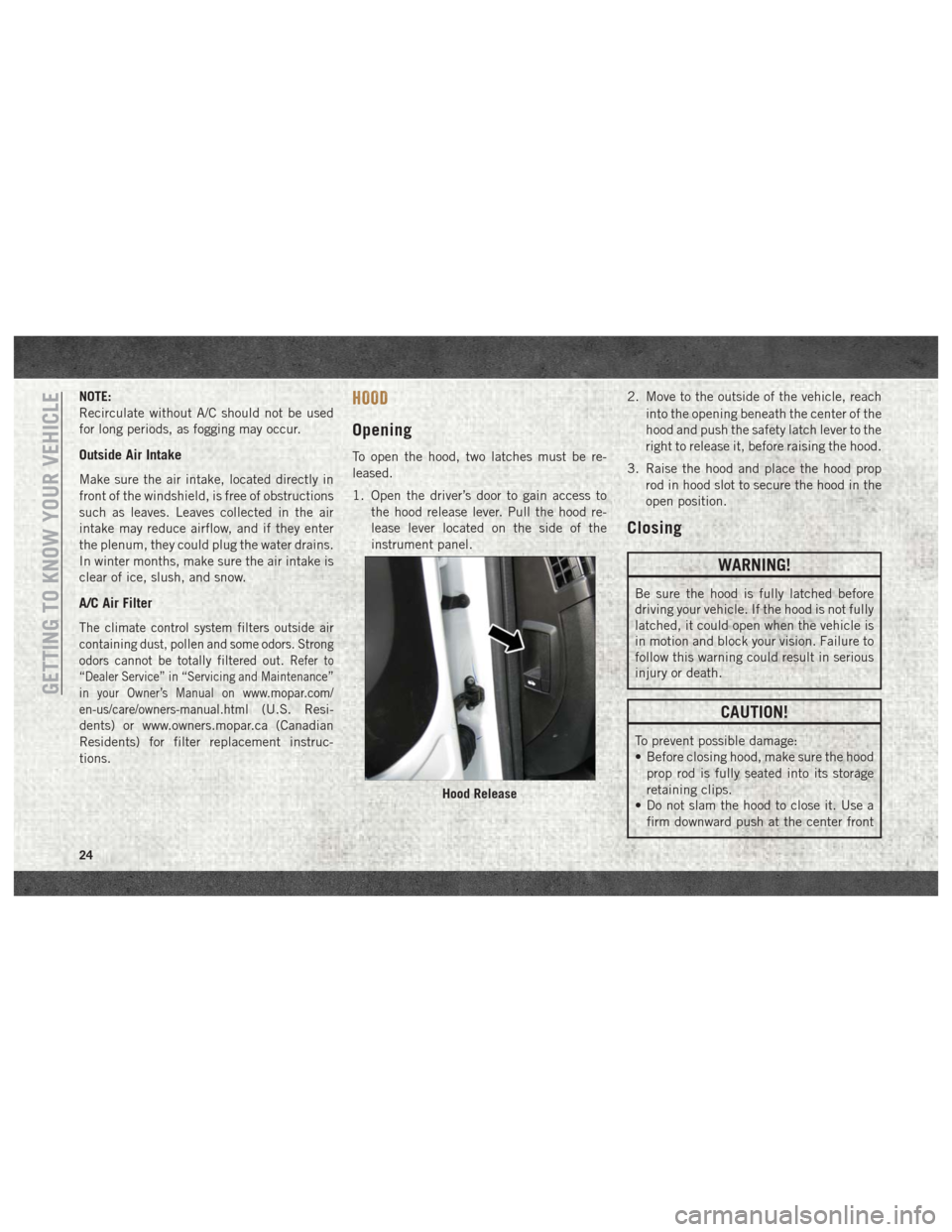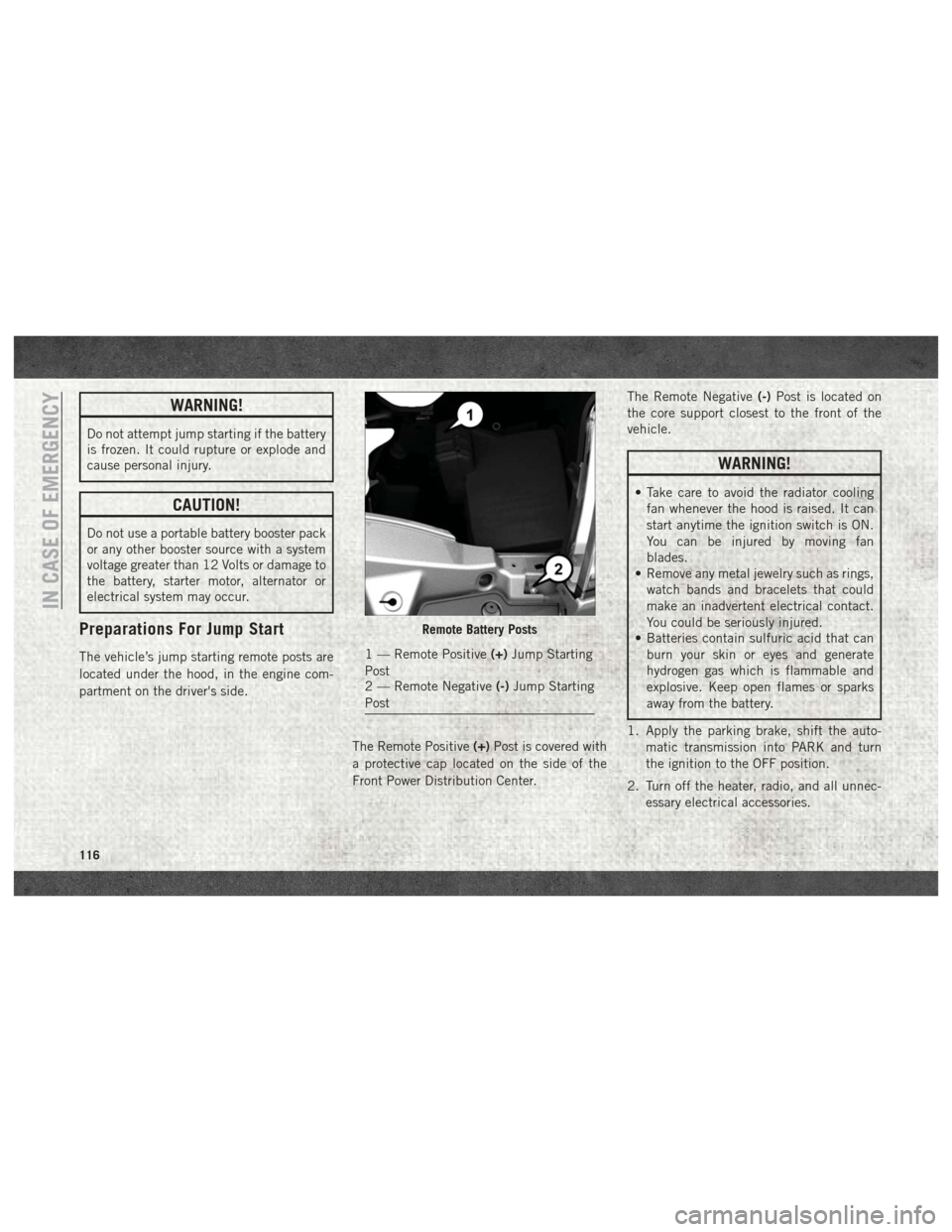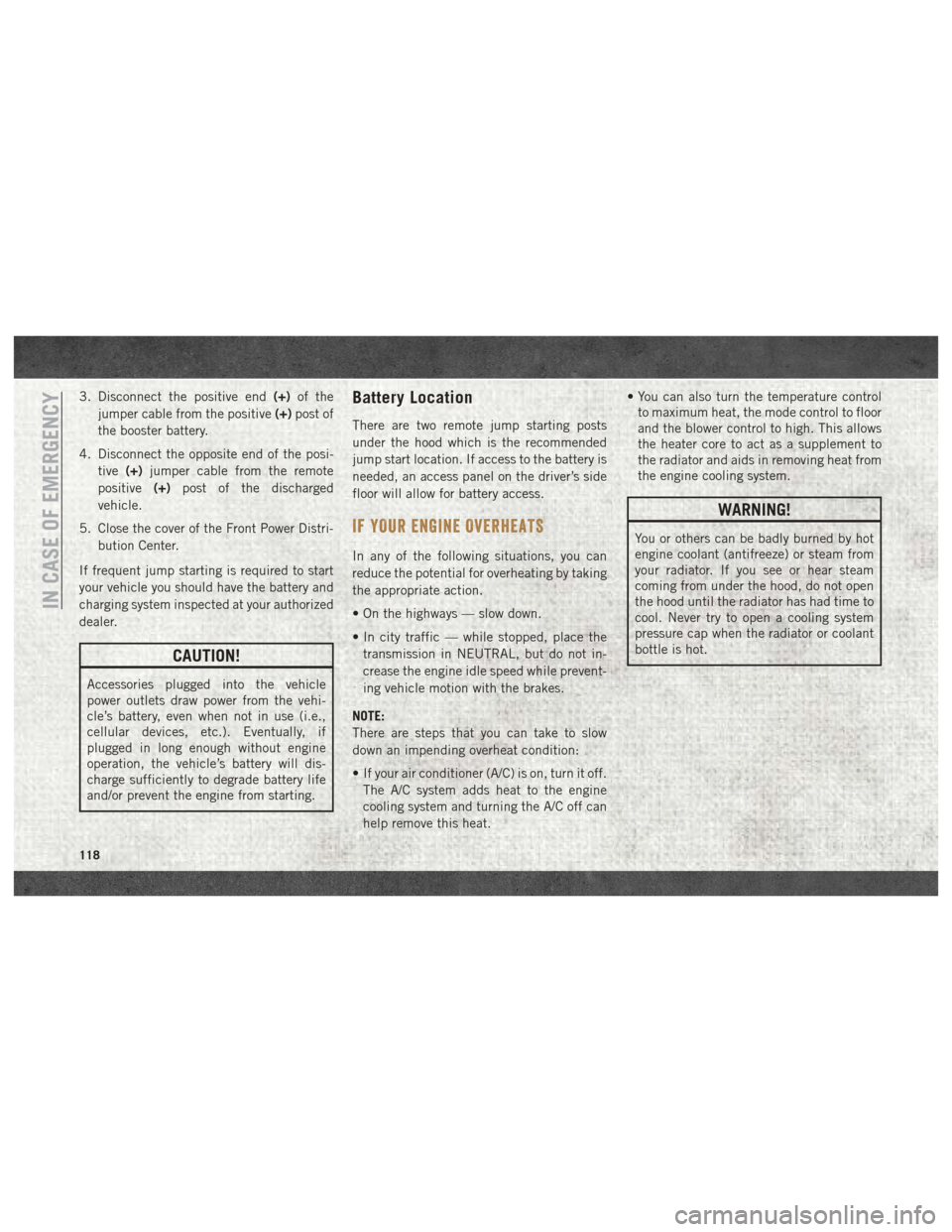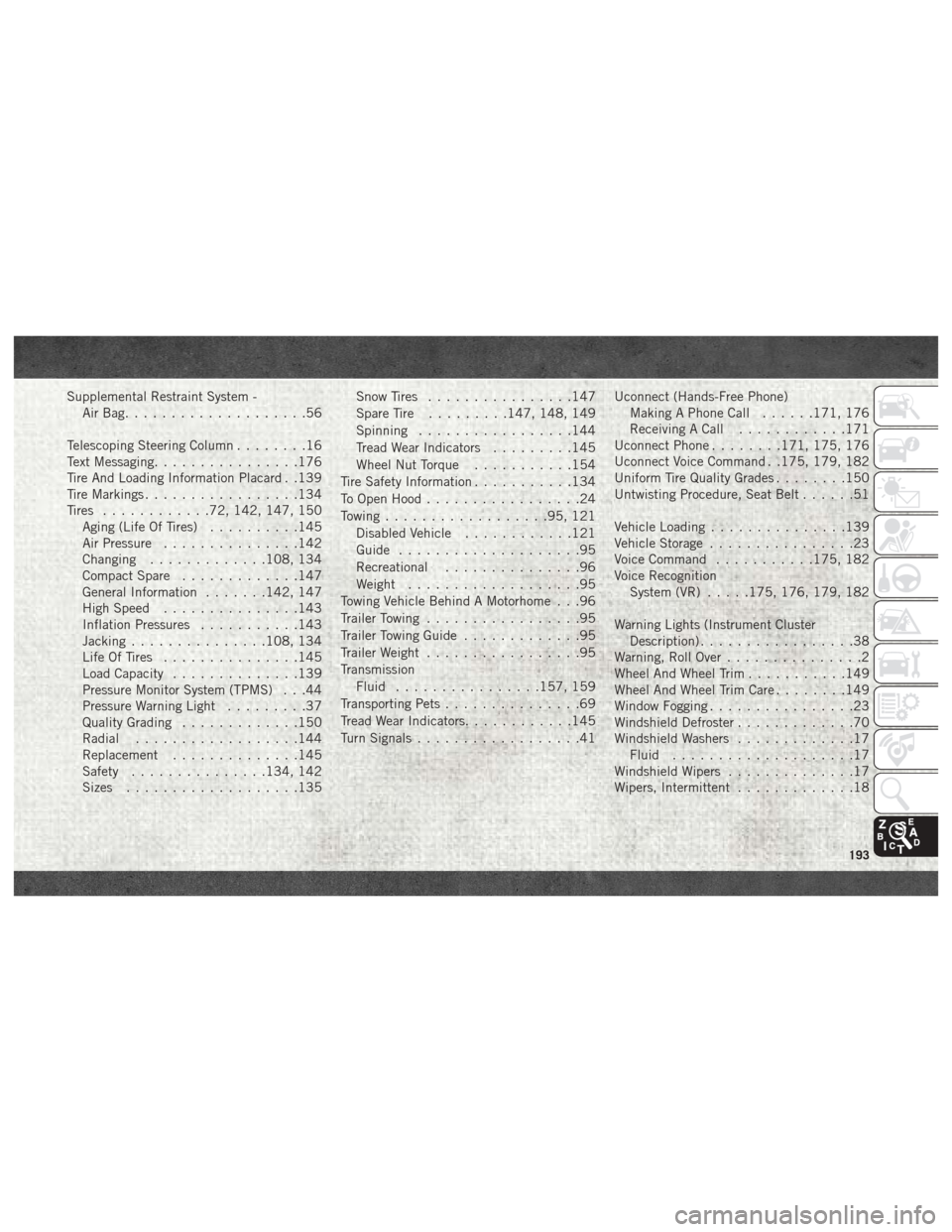hood open Ram ProMaster 2018 User Guide
[x] Cancel search | Manufacturer: RAM, Model Year: 2018, Model line: ProMaster, Model: Ram ProMaster 2018Pages: 204, PDF Size: 4 MB
Page 13 of 204

GETTING TO KNOW YOUR VEHICLE
KEYS......................12
KeyFob.....................12
SEATS .....................13
Heated Seats — If Equipped ........13
Adjustable Armrests — If Equipped ....14
HEAD RESTRAINTS..............14
Front Head Restraint Adjustment .....15
Front Head Restraint Removal .......15
STEERING WHEEL..............16
Telescoping Steering Column .......16
EXTERIOR LIGHTS..............16
Multifunction Lever ..............16
Headlights ...................17
High Beam/Low Beam Select Switch . . .17
Parking Lights .................17
Turn Signals ..................17
Lane Change Assist .............17
INTERIOR LIGHTS...............17
WIPERS AND WASHERS ..........17
Front Wiper Operation............17
CLIMATE CONTROLS.............19
Manual Climate Control Overview .....19
Climate Control Functions ..........22
Operating Tips .................23
HOOD......................24
Opening .....................24
Closing .....................24
INTERNAL EQUIPMENT ...........25
Power Outlets.................25
GETTING TO KNOW YOUR VEHICLE
11
Page 26 of 204

NOTE:
Recirculate without A/C should not be used
for long periods, as fogging may occur.
Outside Air Intake
Make sure the air intake, located directly in
front of the windshield, is free of obstructions
such as leaves. Leaves collected in the air
intake may reduce airflow, and if they enter
the plenum, they could plug the water drains.
In winter months, make sure the air intake is
clear of ice, slush, and snow.
A/C Air Filter
The climate control system filters outside air
containing dust, pollen and some odors. Strong
odors cannot be totally filtered out.
Refer to
“Dealer Service” in “Servicing and Maintenance”
in your Owner’s Manual on
www.mopar.com/
en-us/care/owners-manual.html
(U.S. Resi-
dents) or www.owners.mopar.ca (Canadian
Residents) for filter replacement instruc-
tions.
HOOD
Opening
To open the hood, two latches must be re-
leased.
1. Open the driver’s door to gain access to the hood release lever. Pull the hood re-
lease lever located on the side of the
instrument panel. 2. Move to the outside of the vehicle, reach
into the opening beneath the center of the
hood and push the safety latch lever to the
right to release it, before raising the hood.
3. Raise the hood and place the hood prop rod in hood slot to secure the hood in the
open position.
Closing
WARNING!
Be sure the hood is fully latched before
driving your vehicle. If the hood is not fully
latched, it could open when the vehicle is
in motion and block your vision. Failure to
follow this warning could result in serious
injury or death.
CAUTION!
To prevent possible damage:
• Before closing hood, make sure the hoodprop rod is fully seated into its storage
retaining clips.
• Do not slam the hood to close it. Use a
firm downward push at the center front
Hood Release
GETTING TO KNOW YOUR VEHICLE
24
Page 118 of 204

WARNING!
Do not attempt jump starting if the battery
is frozen. It could rupture or explode and
cause personal injury.
CAUTION!
Do not use a portable battery booster pack
or any other booster source with a system
voltage greater than 12 Volts or damage to
the battery, starter motor, alternator or
electrical system may occur.
Preparations For Jump Start
The vehicle’s jump starting remote posts are
located under the hood, in the engine com-
partment on the driver's side.The Remote Positive(+)Post is covered with
a protective cap located on the side of the
Front Power Distribution Center. The Remote Negative
(-)Post is located on
the core support closest to the front of the
vehicle.
WARNING!
• Take care to avoid the radiator cooling fan whenever the hood is raised. It can
start anytime the ignition switch is ON.
You can be injured by moving fan
blades.
• Remove any metal jewelry such as rings,
watch bands and bracelets that could
make an inadvertent electrical contact.
You could be seriously injured.
• Batteries contain sulfuric acid that can
burn your skin or eyes and generate
hydrogen gas which is flammable and
explosive. Keep open flames or sparks
away from the battery.
1. Apply the parking brake, shift the auto- matic transmission into PARK and turn
the ignition to the OFF position.
2. Turn off the heater, radio, and all unnec- essary electrical accessories.
Remote Battery Posts
1 — Remote Positive (+)Jump Starting
Post
2 — Remote Negative (-)Jump Starting
Post
IN CASE OF EMERGENCY
116
Page 120 of 204

3. Disconnect the positive end(+)of the
jumper cable from the positive (+)post of
the booster battery.
4. Disconnect the opposite end of the posi- tive (+)jumper cable from the remote
positive (+)post of the discharged
vehicle.
5. Close the cover of the Front Power Distri- bution Center.
If frequent jump starting is required to start
your vehicle you should have the battery and
charging system inspected at your authorized
dealer.
CAUTION!
Accessories plugged into the vehicle
power outlets draw power from the vehi-
cle’s battery, even when not in use (i.e.,
cellular devices, etc.). Eventually, if
plugged in long enough without engine
operation, the vehicle’s battery will dis-
charge sufficiently to degrade battery life
and/or prevent the engine from starting.
Battery Location
There are two remote jump starting posts
under the hood which is the recommended
jump start location. If access to the battery is
needed, an access panel on the driver’s side
floor will allow for battery access.
IF YOUR ENGINE OVERHEATS
In any of the following situations, you can
reduce the potential for overheating by taking
the appropriate action.
• On the highways — slow down.
• In city traffic — while stopped, place the transmission in NEUTRAL, but do not in-
crease the engine idle speed while prevent-
ing vehicle motion with the brakes.
NOTE:
There are steps that you can take to slow
down an impending overheat condition:
• If your air conditioner (A/C) is on, turn it off. The A/C system adds heat to the engine
cooling system and turning the A/C off can
help remove this heat. • You can also turn the temperature control
to maximum heat, the mode control to floor
and the blower control to high. This allows
the heater core to act as a supplement to
the radiator and aids in removing heat from
the engine cooling system.
WARNING!
You or others can be badly burned by hot
engine coolant (antifreeze) or steam from
your radiator. If you see or hear steam
coming from under the hood, do not open
the hood until the radiator has had time to
cool. Never try to open a cooling system
pressure cap when the radiator or coolant
bottle is hot.
IN CASE OF EMERGENCY
118
Page 195 of 204

Supplemental Restraint System -AirBag....................56
Telescoping Steering Column ........16
Text Messaging ................176
Tire And Loading Information Placard . .139
Tire Markings .................134
Tires ............72, 142, 147, 150
Aging (Life Of Tires) ..........145
Air Pressure ...............142
Changing .............108, 134
Compact Spare .............147
General Information .......142, 147
High Speed ...............143
Inflation Pressures ...........143
Jacking ...............108, 134
Life Of Tires ...............145
Load Capacity ..............139
Pressure Monitor System (TPMS) . . .44
Pressure Warning Light .........37
Quality Grading .............150
Radial ..................144
Replacement ..............145
Safety ...............134, 142
Sizes ...................135 Snow Tires
................147
Spare Tire .........147, 148, 149
Spinning .................144
Tread Wear Indicators .........145
Wheel Nut Torque ...........154
Tire Safety Information ...........134
To Open Hood .................24
Towing ..................95, 121
Disabled Vehicle ............121
Guide ....................95
Recreational ...............96
Weight ...................95
Towing Vehicle Behind A Motorhome . . .96
Trailer Towing .................95
Trailer Towing Guide .............95
Trailer Weight .................95
Transmission Fluid ............... .157, 159
T
ransporting Pets ...............69
Tread Wear Indicators ............145
Turn Signals ..................41 Uconnect (Hands-Free Phone)
Making A Phone Call ......171, 176
Receiving A Call ............171
Uconnect Phone ........171, 175, 176
Uconnect Voice Command . .175, 179, 182
Uniform Tire Quality Grades ........150
Untwisting Procedure, Seat Belt ......51
Vehicle Loading ...............139
Vehicle Storage ................23
Voice Command ...........175, 182
Voice Recognition System (VR) .....175, 176, 179, 182
Warning Lights (Instrument Cluster Description) .................38
Warning, Roll Over ...............2
Wheel And Wheel Trim ...........149
Wheel And Wheel Trim Care ........149
Window Fogging ................23
Windshield Defroster .............70
Windshield Washers .............17
Fluid ....................17
Windshield Wipers ..............17
Wipers, Intermittent .............18
193